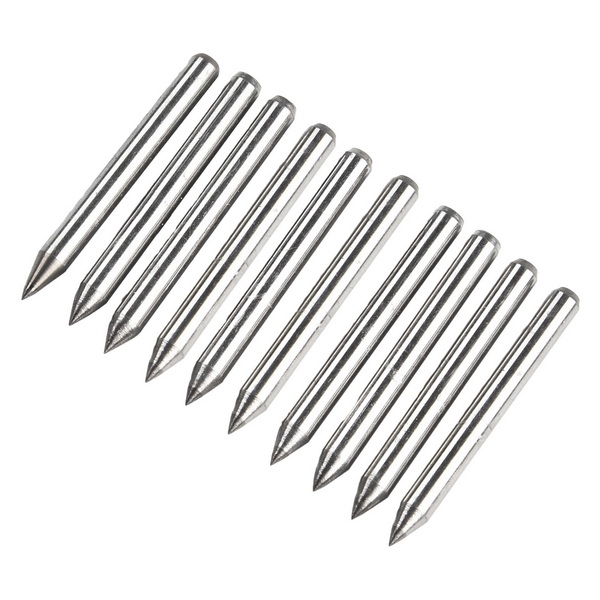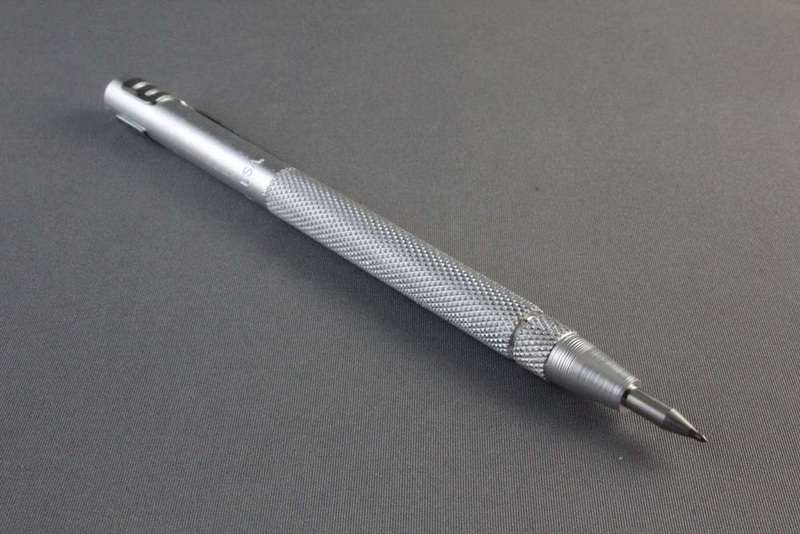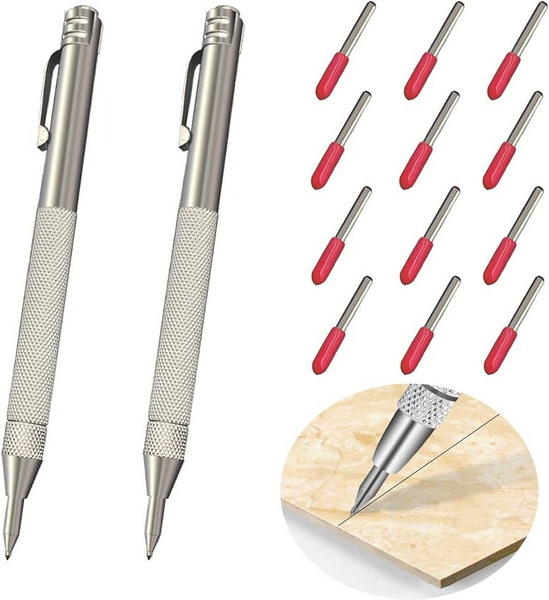Content Menu
● What Is a Tungsten Carbide Scribe?
● Material Properties of Tungsten Carbide
● What Materials Can a Tungsten Carbide Scribe Scratch?
>> Metals
>> Non-Metallic Hard Materials
>> Other Surfaces
● How Does a Tungsten Carbide Scribe Work?
● Expanded Applications of Tungsten Carbide Scribes
>> Industrial Manufacturing
>> Automotive Industry
>> Electronics and Circuit Board Fabrication
>> Jewelry Making
>> Archaeology and Paleontology
>> Glass and Ceramic Crafting
● Comparison with Other Scribing Tools
● Safety Tips and Best Practices
● Detailed Maintenance and Care Instructions
● Conclusion
● FAQ
>> 1. What materials can a tungsten carbide scribe scratch?
>> 2. How hard is tungsten carbide compared to other materials?
>> 3. Can a tungsten carbide scribe scratch a diamond?
>> 4. How do I sharpen a tungsten carbide scribe?
>> 5. Is a tungsten carbide scribe brittle?
Tungsten carbide scribes are precision tools widely used in metalworking, engineering, geology, and crafts for marking and engraving hard surfaces. Their remarkable hardness and durability make them ideal for scribing on materials that are difficult or impossible to mark with conventional tools like pencils or pens. This article explores what materials a tungsten carbide scribe can scratch, how it works, its applications, and tips for use and maintenance. We will also include detailed images illustrating the tool and its effects on various materials.

What Is a Tungsten Carbide Scribe?
A tungsten carbide scribe is a hand tool featuring a sharp tip made of tungsten carbide, a compound known for its extreme hardness and wear resistance. The tip is typically ground into a fine point or taper, allowing it to make precise, permanent marks by scratching the surface of hard materials.
- Material Composition: Tungsten carbide has a hardness rating of about 8.5 to 9 on the Mohs scale, making it one of the hardest materials available for tool tips.
- Design: The scribe usually has a brass or aluminum handle with knurling for a secure grip, and the carbide tip is often replaceable or sharpenable.
- Durability: The tip resists wear and can be sharpened on diamond plates or silicon carbide stones to maintain precision.
Material Properties of Tungsten Carbide
Tungsten carbide is a composite material made from tungsten and carbon atoms bonded together in a crystalline structure. This unique composition gives it exceptional hardness, toughness, and resistance to wear and corrosion. The hardness of tungsten carbide is typically around 8.5 to 9 on the Mohs scale, which is significantly harder than most steels and many other metals. This hardness allows the scribe tip to maintain a sharp edge for a long time, even under heavy use.
In addition to hardness, tungsten carbide exhibits excellent thermal conductivity and can withstand high temperatures without losing its structural integrity. This makes it suitable for use in environments where heat generation is a concern, such as machining and metalworking.
The brittleness of tungsten carbide is a trade-off for its hardness. While it is very hard, it can be prone to chipping or cracking if subjected to sudden impacts or excessive force. Therefore, users must handle tungsten carbide scribes with care to avoid damaging the tip.
What Materials Can a Tungsten Carbide Scribe Scratch?
Due to its exceptional hardness, a tungsten carbide scribe can scratch a wide range of materials, including:
Metals
- Hardened Steel: The scribe can mark hardened steel surfaces with sharp, clear lines, essential for precision metalworking.
- Stainless Steel: It can scribe stainless steel, which is otherwise difficult to mark without specialized tools.
- Other Metals: Aluminum, brass, and various alloys can also be scratched effectively.
Non-Metallic Hard Materials
- Glass: The scribe can etch glass surfaces, useful for crafts and industrial marking.
- Ceramics: It can scratch ceramic tiles, allowing for layout and cutting guides.
- Stone and Natural Minerals: Geologists use tungsten carbide scribes to perform scratch tests on minerals and crystals to determine hardness and identify specimens.
- Hard Plastics: Some rigid plastics can be marked with a carbide scribe.
Other Surfaces
- Paint and Rust Layers: The carbide tip can cut through dirt, paint, rust, and mill scale to expose the underlying material for accurate marking.
How Does a Tungsten Carbide Scribe Work?
The tungsten carbide tip works by applying a concentrated force on a very small area, allowing it to penetrate or scratch the surface of hard materials. The key points include:
- Hardness: Tungsten carbide's hardness exceeds that of most metals and minerals, enabling it to scratch surfaces that softer tools cannot.
- Tip Shape: The fine tapered point concentrates pressure, making it easier to create precise lines.
- User Technique: Applying consistent, moderate pressure similar to writing with a pen ensures longevity of the tip and clean marks.
Expanded Applications of Tungsten Carbide Scribes
Industrial Manufacturing
In industrial manufacturing, tungsten carbide scribes are used extensively for marking metal sheets, pipes, and components before cutting, welding, or machining. Their ability to create precise, permanent marks helps improve accuracy and reduce material waste. For example, in aerospace manufacturing, scribes mark aluminum and titanium parts where precision is critical.
Automotive Industry
Automotive technicians use tungsten carbide scribes to mark parts for repair or replacement. The scribes can mark on painted surfaces, metal parts, and even glass components, making them versatile tools in automotive diagnostics and bodywork. They are also used to mark alignment points during assembly or disassembly.
Electronics and Circuit Board Fabrication
In electronics manufacturing, scribes are used to mark circuit boards and components for assembly and quality control. The fine tip allows for detailed markings without damaging sensitive parts. This is crucial for identifying components and ensuring proper placement during soldering.
Jewelry Making
Jewelry artisans use tungsten carbide scribes to engrave designs on metals like gold, silver, and platinum. The precision and durability of the scribe make it ideal for intricate work such as engraving fine patterns, initials, or decorative elements on rings and pendants.
Archaeology and Paleontology
Researchers use tungsten carbide scribes to carefully mark and label artifacts and fossils without causing significant damage. The tool's precision helps in cataloging and study, allowing for non-destructive marking on delicate surfaces.
Glass and Ceramic Crafting
Artists and craftsmen use tungsten carbide scribes to etch designs on glassware and ceramic tiles. The scribe allows for detailed patterns to be scratched into surfaces before firing or finishing, creating permanent decorative effects.

Comparison with Other Scribing Tools
While tungsten carbide scribes are highly effective, it is useful to compare them with other common scribing tools:
| Tool Type | Hardness Level (Mohs) | Durability | Cost | Typical Uses |
| Steel Scribes | 5-6 | Low | Low | Soft metals, wood, general marking |
| Tungsten Carbide | 8.5-9 | High | Moderate | Hard metals, glass, ceramics |
| Diamond-Tipped | 10 | Very High | High | Extreme hardness, diamonds, glass |
| Ceramic Scribes | 7-8 | Moderate | Moderate | Specific ceramics, delicate work |
- Steel Scribes: Less expensive but wear out quickly and cannot mark very hard materials effectively.
- Diamond-Tipped Scribes: Harder than tungsten carbide and can mark even diamond surfaces, but they are more expensive and brittle.
- Ceramic Scribes: Hard but can be fragile and less versatile.
Tungsten carbide scribes strike a balance between hardness, durability, and cost, making them a popular choice for many applications.
Safety Tips and Best Practices
- Always wear safety glasses when using a tungsten carbide scribe to protect your eyes from metal or glass shards.
- Use moderate pressure to avoid chipping the tip.
- Keep the workpiece securely clamped to prevent slips.
- Store the scribe in a protective case to avoid accidental injury or damage.
- Avoid using the scribe on very brittle materials without proper support to prevent cracking.
- Use gloves if working with sharp or rough materials to protect your hands.
Detailed Maintenance and Care Instructions
- Regularly inspect the tip for signs of wear or damage.
- Sharpen the tip using diamond sharpening plates or silicon carbide stones as needed.
- Clean the tip after each use to remove debris and prevent corrosion.
- Replace the tip if it becomes excessively worn or damaged.
- Avoid dropping the scribe, as the brittle carbide tip can chip or break.
- Store the scribe in a dry place to prevent handle corrosion and tip oxidation.
Conclusion
A tungsten carbide scribe is an indispensable tool for anyone working with hard materials. Its extreme hardness allows it to scratch metals, glass, ceramics, and minerals with precision and durability unmatched by conventional scribers. Whether used for metalworking layout, geological hardness testing, or craft engraving, this tool provides clean, permanent marks essential for accuracy and quality. Proper care, sharpening, and handling ensure that a tungsten carbide scribe remains a reliable companion in professional and hobbyist toolkits alike.

FAQ
1. What materials can a tungsten carbide scribe scratch?
A tungsten carbide scribe can scratch hardened steel, stainless steel, glass, ceramics, stone, minerals, and some hard plastics. It can also cut through surface layers like paint and rust for accurate marking.
2. How hard is tungsten carbide compared to other materials?
Tungsten carbide rates about 8.5 to 9 on the Mohs hardness scale, making it harder than most metals and many minerals, but softer than diamond.
3. Can a tungsten carbide scribe scratch a diamond?
No, diamonds are harder than tungsten carbide. Tungsten carbide cannot scratch diamond but can scratch almost all other common materials.
4. How do I sharpen a tungsten carbide scribe?
Use diamond sharpening plates or silicon carbide stones to carefully restore the sharp point of the scribe tip.
5. Is a tungsten carbide scribe brittle?
Tungsten carbide is very hard but can be brittle. Excessive force or impact can cause chipping or breaking of the tip, so moderate pressure is recommended during use.
















